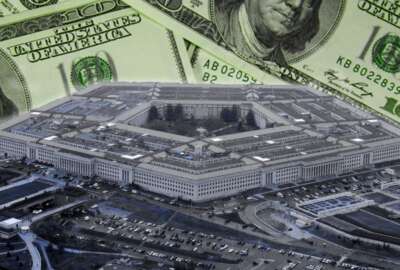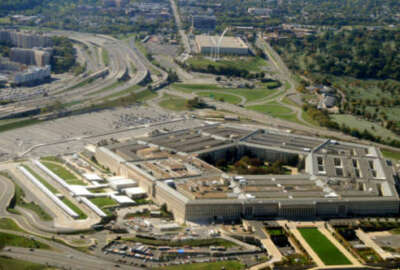
Pentagon reports $5B in improper payments to civilian workforce
The newly-reported improper payments come a year after a similar testing overhaul flagged billions of dollars in potentially unsupportable payments in DoD's...
The DoD Reporter’s Notebook is a weekly summary of personnel, acquisition, technology and management stories that may have fallen below your radar during the past week, but are nonetheless important. It’s compiled and published each Monday by Federal News Network DoD reporters Jared Serbu and Scott Maucione
Most newly-detected civilian pay discrepancies were due to missing documentation
The Defense Department’s latest financial statement shows the Pentagon made nearly $5 billion worth of improper payments in its civilian payroll accounts last year, a massive increase from previous years in which the department reported almost none.
In its annual financial report, released last week, DoD said the startling increase was mainly because of a “new sampling plan and testing methodology” financial management officials began implementing in the civilian pay accounts in 2020. But at least so far, those new methodologies appear to have generated more questions than answers as they unearthed billions of dollars in previously-undiscovered potential payment irregularities.
For the overwhelming majority of the $4.916 billion discovered to be improper in the civilian pay arena — 99.1% — auditors aren’t able to say whether they represent overpayments or underpayments. Instead, the department simply doesn’t have the documentation to show whether the payments were authorized at all.
Overall, the new tests showed that nearly 8% of the department’s outlays to its civilian workforce could be improper in one way or another, according to the new data. In 2019, prior to the new sampling and testing processes, the department estimated just 0.14% of its civilian payments were improper.
The newly-reported improper payments for civilians were a major driving factor in the total payment discrepancy rate across the department. In 2020, improper payments stood at 1.73% of DoD’s total spending, compared to 1.43% in 2019, representing an increase of $2.7 billion and raising DoD’s total estimated improper payment amount to $11.4 billion. More than $9 billion of that figure is categorized as “unknown,” meaning the department cannot say whether they were underpayments, overpayments, or, perhaps perfectly justified.
Another major driver of the “unknown” category is DoD’s military pay accounts. In 2019, when the department implemented a similar sampling and testing overhaul for those accounts, the improper payment rate for military pay rose from 6.95% to 7.25%, totaling $7.45 billion.
The department made some progress against that military pay error rate in 2020, but military pay still accounts for $5.2 billion of the department’s improper payments.
However, this year’s report marks the first time DoD’s financial report breaks improper military payments down by military service, and the problems appear to be overwhelmingly in the Army and Air Force, which reported error rates of 8.14% and 5.64%, respectively. Those two services were responsible for $5.1 billion in improper military payments; the Navy and Marine Corps made just $52 million.
And the same appears to be true for those newly-discovered improper payments in the civilian pay area. Although the report doesn’t break improper civilian payments down by DoD component, it does note that the Navy and Marine Corps have estimated improper payment rates of less than 1% in the civilian category.
Federal law requires agencies to publish corrective action plans whenever audits turn up estimated improper payments of $100 million or more in a particular spending category, and DoD crossed that threshold and published a new one for civilian pay in 2020.
The plan called for the department to accelerate post-payment reviews and identify points of contact for identifying improper payments in each DoD component by this month. By next month, the department is supposed to hold a civilian pay “entrance conference,” in part, to make sure “key stakeholders” understand what documentation is needed to support civilian payments.
Another milestone in the corrective action plan is set for next May, when the department will start developing monthly reports on its progress and how much documentation is still missing, and roll out a new software platform to collect data and documentation on civilian improper payments.
Aside from civilian pay, DoD still has significant improper payment problems in four other areas:
- Military health benefits: Improper payment rate of 1.46%, or $339 million
- Military retirement: Improper payment rate of 0.48%, or $352 million
- Travel pay: Improper payment rate of 4.27%, or $315 million
- Payments to contractors: Improper payment rate of 0.08%, or $307 million
But those categories do not suffer from missing documentation problems to nearly the degree DoD’s personnel pay accounts do. For more than 99% of the improper payments in those latter four areas, the department is at least able to tell whether they were overpayments or overpayments, theoretically letting officials chase down overpayments or make good on underpayments after the fact. —JS
Pentagon tells more employees to telework in response to rise in D.C.-area COVID cases
The Defense Department will once again ramp up coronavirus protective measures in place for employees at the Pentagon later this week in response to a resurgence of the virus nationwide, including in the National Capital Region.
Starting on Thanksgiving Day, the Pentagon reservation — which includes the nearby Mark Center and DoD-leased space — will move from Health Protection Condition Bravo to a new subcategory the department is calling “Bravo-Plus.”
It won’t mean a return to the full set of precautions officials implemented at the Pentagon in March, when they set HPCON Charlie. Those were relaxed in June, when the Pentagon downgraded itself to HPCON Bravo.
But under “Bravo-Plus,” the changes will include:
- A target of 60% of employees teleworking, up from 20% under HPCON Bravo
- Gatherings of more than 25 people are banned, compared to 50 people under HPCON Bravo
- No more seating at Pentagon food courts, which will become take-out-only
- 5%-15% of employees coming to work will be randomly screened with temperature checks and health questionnaires
- Reduced capacity at the Pentagon Health Center
DoD Chief Management Officer Lisa Hershman, who approved the new restrictions, said the two DoD-managed Armed Forces Retirement Homes in Washington and Gulfport, Mississippi, which also fall under her purview, will stay at HPCON Delta — DoD’s highest level of restrictions. —JS
Army rethinking sexual harassment and assault prevention program
The Army will take a hard look at its sexual assault and harassment prevention program after a serious of violent incidents at Ft. Hood in Texas and other bases.
In a video message posted on Twitter last week, Army Secretary Ryan McCarthy said he reviewed the preliminary findings of the Ft. Hood Review Committee and will require the Army to make serious changes to it Sexual Harassment Assault Response Prevention (SHARP) program.
“Recent cases and recent media coverage have hardened my belief that the Army’s SHARP program hasn’t achieved its mandate to eliminate sexual assault and sexual harassment by creating a climate that respects the dignity of every member of the Army family,” McCarthy said.
On Dec. 8, the Army will release the committee’s review with an action plan to address the recommendations.
“It is clear we have significant work to do to regain our soldiers’ trust in our SHARP program,” McCarthy said.
Much of the Army’s introspection about its sexual assault and harassment problem came after the harassment and murder of Army Specialist Vanessa Guillen this summer. However, advocacy groups have been warning for years that sexual assault is a glaring problem in the military.
Guillen’s death sparked a worldwide movement of service members and veterans divulging their sexual harassment and assault stories.
Military sexual assault and harassment numbers are on the rise.
The inspector general for Army Forces Command visited Ft. Hood this summer. Soldiers told the office they trusted senior leaders to take sexual harassment seriously, but the junior leaders may not have the life experience or the military experience to deal with the situation as it was presented to them.
FORCECOM Inspector General Col. Patrick Wempe said his office noticed issues with SHARP.
“At Ft. Hood we observed the SHARP program needing to improve in certain areas, but one which units generally execute the standard,” Wempe said. “Soldiers reported a hesitancy to report SHARP incidents for several disparate reasons.”
The Army has made some adjustments this year to try to raise the alarm about people in possibly dangerous situations.
In October, the service announced that when soldiers do not show up for duty that they will be reported missing instead of jumping to the more disciplinary absent-without-leave status.
“Spec. Vanessa Guillen really affected all of us. Incredible soldier. We know her family and I think she touched every one of us. What happened to her was horrific,” Army Chief of Staff Gen. James McConville said last month. “What we’re putting in place is basically a missing category, because that’s really — what happened to Vanessa Guillen; she was not absent without leave. But she wasn’t present for duty either. She was missing. We want to have a category that’s clear and unequivocal, that if you’re not present for duty, you’re missing. Then the intent is for that unit, and for the Army, to be looking for that soldier.” — SM
More than 50,000 soldiers have a chance to get new benefits
Tens of thousands of Army veterans who were less-than-honorably discharged will now get a second chance to receive benefits.
After lengthy court battle, soldiers who have less-than-honorable discharges after Oct. 7, 2001, relating to mental health or sexual trauma will have their discharges reviewed by the Army.
“This settlement will ensure that the Army reconsiders thousands of decisions involving Iraq- and Afghanistan-era veterans with a less-than-fully-honorable discharge,” according to a statement by the Yale Law School Veterans Legal Service Clinic.
The clinic provided legal counsel for the class action suit against the Army.
“Additionally, the Army will adopt procedural reforms, such as a universal telephonic hearing program, that will facilitate access to discharge upgrades for this and future generations,” the statement continued.”
The Army Discharge Review Board and the plaintiffs reached a settlement last Wednesday, which will automatically consider thousands of cases dating back to April 2011. Former soldiers discharged before that will receive notice that they may reapply for benefits.
The Army also agreed to make other changes to the board’s process. There will be additional training for board members and staff, enhanced notices to veterans of legal and medical services that might assist their applications, and more detailed documentation requirements that the ADRB must follow in any written denials.
The new telephonic hearings option is particularly important because now former soldiers will not have to travel to Washington to appear in person for discharge upgrade hearings.
“This is a watershed vindication of veterans’ rights,” said plaintiff Steve Kennedy, who served in Iraq and is a founder of the Connecticut chapter of the Iraq and Afghanistan Veterans of America. “Not only will this have a practical impact on the lives of thousands of veterans, but this settlement will also signal that the federal government must be held accountable to its word to veterans.”
Sen. Richard Blumenthal (D-Conn.) added, “I am elated by this historic victory — resulting from a relentless fight for justice. After three years of tireless effort from a great team led by the Yale Law School Veterans Legal Services Clinic and thousands of Army veterans, we can celebrate this significant step forward. Heroic veterans suffering from the invisible wounds of war deserve support and treatment, not the stain and stigma of a less-than-honorable discharge. I’m proud to see that this injustice has been righted for an entire generation of Army servicemen and women.” — SM
New SPACECOM for Marines, headquarters location coming soon
It’s been an exciting time to be a space command lately. The Marine Corps set up its own service-specific space command and the Air Force is honing in on where it will headquarter U.S. Space Command next year.
Marine Corps Forces Space Command is now operational, and being led by Maj. Gen. Matthew Glavy.
The command was created from the existing Marine space experts who were previously stationed with U.S. Strategic Command.
MARFORSPACE will “focus on providing space operational support to the Fleet Marine Force while building a convergence capability to increase warfighter lethality,” according to a release from the Marine Corps.
“We have an incredible opportunity to create a synergy across the information environment based on our unique position within the naval and joint force,” Glavy said. “Space and cyber are critical capabilities in the information environment that, when brought together, can provide a competitive advantage. Convergence requires flexible and interconnected teams focused on solving hard problems with speed. We cannot be successful in these technology-heavy domains without prioritizing people, ideas and things in that order.”
Glavy will be dual hatted as the leader of Marine Corps Forces Cyberspace Command as well.
On a larger scale, the Air Force announced six possible locations where SPACECOM headquarters may be located. The candidates are:
- Kirkland Air Force Base in New Mexico,
- Offutt Air Force Base in Nebraska,
- Patrick Air Force Base in Florida,
- Peterson Air Force Base in Colorado,
- Port San Antonio in Texas, and
- Redstone Army Airfield in Alabama.
SPACECOM is temporarily headquartered at Peterson Air Force Base. The Air Force considered 24 communities before narrowing it down to six.
“The Department of the Air Force evaluated each location and will now conduct both virtual and on-site visits at each candidate location to assess which location is best suited to host the U.S. Space Command Headquarters,” said Air Force spokesperson Ann Stefanek. “This assessment will be based on factors related to mission, infrastructure capacity, community support, and costs to the Department of Defense.”
The Air Force plans to pick a location early next year. — SM
Copyright © 2025 Federal News Network. All rights reserved. This website is not intended for users located within the European Economic Area.
Jared Serbu is deputy editor of Federal News Network and reports on the Defense Department’s contracting, legislative, workforce and IT issues.
Follow @jserbuWFED
Scott Maucione is a defense reporter for Federal News Network and reports on human capital, workforce and the Defense Department at-large.
Follow @smaucioneWFED
Related Stories






